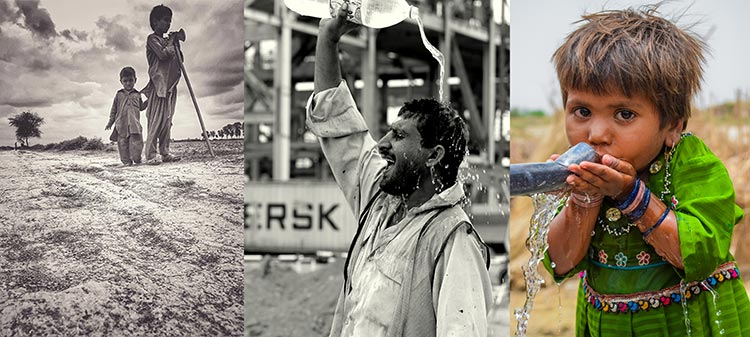Written by: Hamad Ali
Posted on: January 04, 2019 |  | 中文
| 中文
A fisher man drying his clothes after washing in Indus River, Sukkur, Sindh by Dileep Parmar
Although the land meets the sea in Karachi, and there’s ample amount of sea water, the fresh water crisis seems to be getting worse day by day with no immediate solution in sight. NGOs and corporate organizations have been working to mitigate the water shortage in the city. But the first step is to create awareness among people about the possible problems that this water shortage might bring with it. In similar vein, a photography exhibition titled ‘Pani Hai Zindagi, (Water is Life)’ opened on 29th December 2018, at ArtChowk Gallery.
Pani Hai Zindagi was conceived in collaboration with Mr Tofiq Pasha Mooraj, an eminent environmentalist whose tireless efforts are bringing mass awareness among the Karachiites. Mr Pasha, a member of the Hisaar Foundation which works for the security of livelihood, food, and water, in a conversation with Youlin Magazine, said that this exhibition is one of the many events that will lead to the water conference to be held in November 2019.
This is ArtChowk’s second venture after their successful exhibition ‘Kurray se Art Banao’ (Make Art out of Trash). In response to an open call, students, artists, and photographers submitted photographs that resonated with the theme of ‘Pani hai Zindagi.’ “We try to create awareness about the pressing social issues in our city,” said Shakira Masood, the director of the gallery. The exhibition was judged by Tapu Javeri, Tofiq Pasha Mooraj, and Farah Mahbub. Zobia Shah won the 1st position, Mujtaba Raza won the 2nd position and Emmanual Guddu Mansingh won the 3rd position in the competition.

The 40 photographs on display, besides depicting a serious issue, were also aesthetically pleasing. Bilal Danish, a photographer from the Goethe Institut Karachi, captured a scene at the Water Hydrant in North Nazimabad, highlighting the water tanker mafia and how many livelihoods are secure because of that. “The government is trying to get rid of the water tankers to deal with the mafia, but there is an array of working class whose lives rely on the job that these hydrants offer,” said Danish. Rendered in monochromatic tones, his angle and timing produced a photograph which showed great skill.
Another participant, Saima Salahuddin, responded to this theme in a unique and personal manner. Her work, which seemed inspired by Han Kang’s 2007 novella ‘The Vegetarian,’ depicted a woman with cracks and ridges in her body, slouching and holding a small plant. The model’s skin was smothered with clay, which had cracked to resemble a dried patch of land, devoid of water. Her work was layered with themes of femininity, body politic, and rebirth, where her female body was analogous to the motherland, evocative of the attempt to save the scarce resource of water.
Where many participants aimed for figurative depictions that were seemingly open to interpretation, a few artists went for macro shots, which also spoke volumes about the crisis. Dileep Parmar, for e.g., showed great finesse in his photograph ‘Dried out well in the Tharparkar’. The depth of the well was accentuated by his editing skills, making it worth viewing, while addressing the issue of water scarcity heads on.
One mustn’t miss the opportunity to experience how uniquely people have responded to this pervasive issue through their photography. The images are on display till the 7th of January 2019 at ArtChowk Gallery.
You may also like: